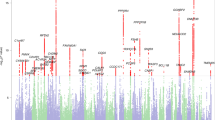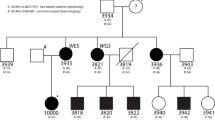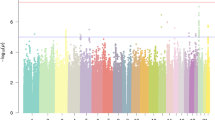Abstract
Family and twin studies of developmental dyslexia have consistently shown that there is a significant heritable component for this disorder. However, any genetic basis for the trait is likely to be complex, involving reduced penetrance, phenocopy, heterogeneity and oligogenic inheritance. This complexity results in reduced power for traditional parametric linkage analysis, where specification of the correct genetic model is important. One strategy is to focus on large multigenerational pedigrees with severe phenotypes and/or apparent simple Mendelian inheritance, as has been success-fully demonstrated for speech and language impairment. This approach is limited by the scarcity of such families. An alternative which has recently become feasible due to the development of high-throughput genotyping techniques is the analysis of large numbers of sib-pairs using allelesharing methodology. This paper outlines our strategy for conducting a systematic genome-wide search for genes involved in dyslexia in a large number of affected sib-pair familites from the UK. We use a series of psychometric tests to obtain different quantitative measures of reading deficit, which should correlate with different components of the dyslexia phenotype, such as phonological awareness and orthographic coding ability. This enables us to use QTL (quantitative trait locus) mapping as a powerful tool for localising genes which may contribute to reading and spelling disability.
Similar content being viewed by others
References
Bisgaard ML, Eiberg H, Moller N, Niebuhr E, Mohr J (1987) Dyslexia and chromosome 15 heteromorphism: negative lod score in a Danish sample. Clin Genet 32:118–119
Cardon LR, Smith SD, Fulker DW, Kimberling WJ, Pennington BF, DeFries JC (1994) Quantitative trait locus for reading disability on chromsome 6. Science 266:276–279
Cardon LR, Smith SD, Fulker DW, Kimberling WJ, Pennington BF, DeFries JC (1995) Quantitative trait locus for reading disability on chromosome 6: a correction. Science 268:1553
Castles A, Coltheart M (1993) Varieties of developmental dyslexia. Cognition 47:149–180
DeFries JC, Fulker DW, LaBuda MC (1987) Evidence for a genetic aetiology in reading disability of twins. Nature 329:537–539
DeFries JC, Gillis JJ (1993) Genetics of reading disability. In: Plomin R, McClearn G (eds) Nature, Nurture, and Psychology, APA Press, Washington, DC
Dib C, Faure S, fizames C, Samson D, Drouot N, Vignal A, et al (1996) A comprehensive genetic map of the human genome based on 5,264 microsatellites. Nature 380:152–154
Fisher SE, Vargha-Khadem F, Watkins KE, Monaco AP, Pembrey ME (1998) Localisation of a gene implicated in a severe speech and language disorder. Nat Genet 18:168–170
Fisher SE, Marlow AJ, Lamb J, Maestrini E, Williams DF, Richardson AJ, Weeks DE et al. (1999) A quantitativetrait locus on chromosome 6p influences different aspects of developmental dyslexia. Am J Hum Genet 64:146–156
Froster U, Schulte-Körne G, Hebebrand J, Remschmidt H (1993) Cosegregation of balanced translocation (1;2) with retarded speech development and dyslexia. Lancet 342:178–179
Geschwind N, Behan PO (1982) Left handedness: Association with immune disease, migraine and developmental learning disorder. Proc Natl Acad Sci USA 79:5097–5100
Grigorenko EL, Wood FB, Meyer MS, Hart LA, Speed WC, Shuster A, Pauls DL (1997) Susceptibility loci for distinct components of developmental dyslexia on chromosomes 6 and 15. Am J Hum Genet 60:27–39
Hallgren B (1950) Specific dyslexia (“congenital word blindness”): a clinical and genetic study. Acta Psychiatr Neurol 65:2–289
Haseman JK, Elston RC (1972) The investigation of linkage between a quantitative trait and a marker locus. Behav Genet 2:3–19
Kruglyak L, Lander ES (1995) Complete multipoint sib-pair analysis of qualitative and quantitative traits. Am J Hum Genet 57:439–454
Lander ES, Schork NJ (1994) Genetic dissection of complex traits. Science 265:2037–2048
Lewitter FI, DeFries JC, Elston RC (1980) Genetic models of reading disabilities. Behav Genet 10:9–30
Lubs HA, Rabin M, Feldman E, Jallad BJ, Kushch A, Gross-Glenn K, et al (1993) Familial dyslexia: genetic and medical findings in eleven 3-generation families. Annal Dyslexia 43:44–60
Morgan WP (1896) A case of congenital word-blindness (inability to learn to read) Br Med J 2:1543–1544
Pennington BF, Gilger JW, Pauls D, Smith SA, Smith SD, DeFries JC (1991) Evidence for major gene transmisson of developmental dyslexia. JAMA 266:1527–1534
Rabin M, Wen XL, Hepburn M, Lubs HA, Feldman E, Duara R (1993) Suggestive linkage of developmental dyslexia to chromsome 1p34-p36. Lancet 342:178
Reed PW, Davies JL, Copeman JB, Bennett ST, Palmer SM, Pritchard LE. et al (1994) Chromosome-specific microsatellite sets for fluorescence-based, semi-automated genome mapping. Nat Genet 7:390–395
Rutter M, Yule W (1975) The concept of specific reading retardation. J Child Psych 16:181–197
Schulte-Körne G, Grimm T, Nöthen MM, Müller-Myhsok B, Propping P, Remschmidt H (1997) Evidence for linkage of spelling disability to chromosome 15. Am J Med Genet 74:661 (abstract)
Smith SD, Gilger JW, Pennington BF (1996) Dyslexia and other specific learning disorders. In: Rimoin DL, Connor JM, Pyeritz RE (eds) Principles and Practice of Medical Genetics. Churchill Livingston. New York. pp 1767–1789
Smith SD, Kimberling WJ, Pennington BF, Lubs HA (1983) Specific reading disability: identification of an inherited form through linkage analysis. Science 219:1345
Thomas CJ (1905) Congenital “word-blindness” and its treatment. Opthalmoscope 3:380–385
Thompson ME (1982) The assessment of children with specific reading disabilities (dyslexia) using the British Ability Scales. Br J Psych 73:461–478
Weeks DE, Lathrop GM (1995) Polygenic disease: methods for mapping complex disease traits. Trends Genet 11:513–519
Author information
Authors and Affiliations
Rights and permissions
About this article
Cite this article
Fisher, S.E., Stein, J.F. & Monaco, A.P. A genome-wide search strategy for identifying quantitative trait loci involved in reading and spelling disability (developmental dyslexia). European Child & Adolescent Psychiatry 8 (Suppl 3), S47–S51 (1999). https://doi.org/10.1007/PL00010694
Issue Date:
DOI: https://doi.org/10.1007/PL00010694




